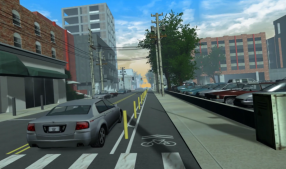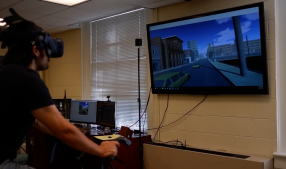Virtual Reality Tool
Virtual Reality As A Tool For Understanding Vulnerable Road User Preference And Reaction
The purpose of this research is to gain an understanding of perceived safety and technological acceptance as it relates to bicyclists, pedestrians, and the road environment. This information can be used by planners and engineers to better design technology and infrastructure for bicyclists and pedestrians.
Rising rates of non-motorized traveler fatalities is an urgent concern in the transportation research community. Standard state and national level crash data sets are derived from police crash reports and are automobile-centric. Analysis of such automobile-centric crash data sets have generally led to improved vehicle occupant safety, while bicyclists and pedestrian fatality rates continue to rise. With limited data available on bicyclist and pedestrian safety, innovative strategies are necessary to improve safety for the most vulnerable road users. The recent advancement of virtual reality technology allows for methods to study bicyclists’ and pedestrians’ perception of safety and acceptance of technology without putting them in any real-life risks.
Recent studies have shown that VR is an effective tool to replicate realistic environmental settings at a low cost and reduced risk to the user. With VR, we can study human behaviors in settings/scenarios that (1) we have limited or no access to (e.g., design of a new intersection that has not been built yet) or (2) are considered high-risk environments for collecting real-life data (e.g., bicyclist safety or crash rates at an intersection and pedestrian crash rates at mid-block crossings). Additionally, these tools provide us the freedom to control and manipulate different variables of interest, which we might not have access to in real-life environments. By coupling VR tools with biometric sensors (e.g., eye trackers, biometric wearables, EEG devices), in addition to behavioral information, users’ physiological information can also be collected and analyzed.

ORCL Bicycle Simulator - Bike Lane with Barriers

ORCL Pedestrian Cell Phone Crossing App Simulation
